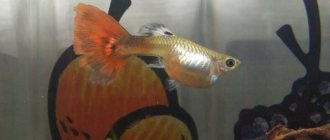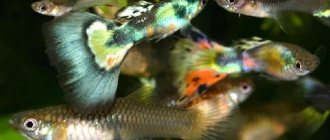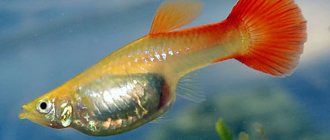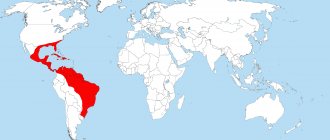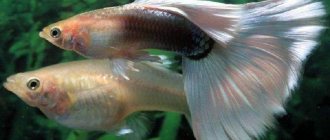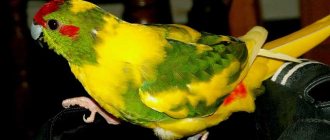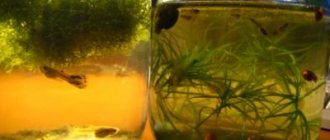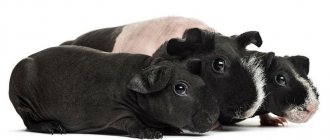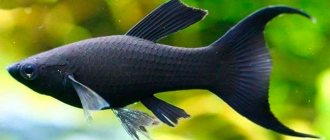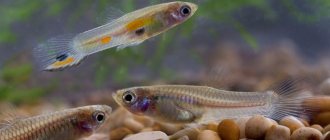Guppies are very bright and active fish, well suited for people who decide to start aquarium farming, as they are unpretentious in care, and offspring are easy to breed. They are viviparous.
Guppy fry do not require very careful care, unlike other types of aquarium fish. A prerequisite after birth is to be separated from adults, otherwise the parents will eat them.
Preparing conditions for a pregnant female
Pregnancy lasts 25–35 days.
Manifests itself in an increase in the size of the abdomen. 2–3 days before birth, the abdomen “squares up” and a dark spot appears behind.
At the final stage of pregnancy, the water is not changed. The temperature is maintained constant.
The optimal water temperature in the aquarium is 24–26 °C.
24–30 hours before giving birth, the female becomes little active, does not eat, and stays near water heating devices.
If separate keeping of juveniles is planned, then the fertilized female is placed in a prepared container with clean, transparent water and plants.
Childbirth
Before labor begins, the female changes her usual behavior and begins to tremble with her whole body. At the moment the fry appears, the female freezes for a couple of seconds, and now the first guppy is already swimming in the water. Later, within an hour, the rest of the fry appear. The fry are very active from the first days, they swim and at the same time look for places of shelter from their adult relatives. The female throws a different number of children at one time, this may depend on her size and age. It also affects the number of births. Children can be from 15 to 100 pieces. for one litter. The length of a newborn is 3.5 mm.
Birth of fry
After one fertilization, the female is able to give birth throughout the year in the absence of a male.
Labor lasts 1–24 hours. Completion is difficult to determine. Leave the female with the fry for 24 hours. If plants are present, the loss of juveniles is minimal.
Quantity
How many fry a guppy gives birth to depends on the age and size of the female, the number of births and the variety.
It is difficult to calculate in a general aquarium. Usually 15–60 individuals. The female can eat a certain amount during childbirth.
What they look like
Baby guppies are born fully formed. Able to feed themselves. Hiding from adult fish.
2–4 mm in length. Colorless to transparent. With big black eyes.
How they grow
The growth rate is affected by the volume of the aquarium and the quality of the water.
During the first week of life, the fry gains 5–7 mm in length. By the end of the second - up to 20 mm. Full size (40–60 mm females, 20–40 mm males) and sexual maturity are reached at 4–5 months.
How to distinguish by gender
Sex differences appear 14 days after birth.
Males are slimmer. Color appears. Females have a smoothly contoured, prominent abdomen and a dark spot next to the anal fin.
Sex differences
Approximately 14-15 days after birth, the fry begin to develop sexual differences.
In male fish, the anal fin, the gonopodium, begins to form. It is located on the abdomen and resembles a small tube in shape, performing the function of a genital organ. Then there is a gradual coloration in bright colors and the growth of a lush tail and dorsal fin.
During this period, females develop a dark spot near the anus; in this place, the fry will be located in the future during pregnancy. The abdomen is also rounded. The color of females does not change much; light shades of yellow, blue and others may appear.
It is important to separate males from females, as earlier fertilization is possible, which negatively affects the health of the fish and future offspring.
Grown-up male fry can be introduced into a common aquarium at the age of 1 month, and females can be released at 4-5 months. Their size should be 2.5-3 cm.
Under favorable conditions, guppies can reproduce monthly. Some females, after a single fertilization, can subsequently bear offspring several times.
Types of food
Guppy fry need live and plant food. Store-bought dry ones contain everything you need, including vitamins.
Commercial feed
Ichthyologists and ichthyopathologists recommend Tetra, Sera, JBL powders.
For fry up to 1 cm long:
- Tetra MicroMin.
- Sera micropan.
- Sera micron.
- JBL NovoTom.
Tetra BioMin paste.
Natural feed
Guppies are omnivores, but the fry need protein for active growth. Protein is abundant in live food. The food is mobile, which awakens the hunting instinct in the fish. Does not spoil water.
In the first days, use home-grown food.
- "Living dust" - ciliate slipper. Size - 0.15–0.25 mm.
- Nauplia is the larva of Artemia. 0.4–0.6 mm in length. It is not used for continuous feeding due to the risk of obesity in the fry.
- Microworm - round worm, nematode. Dimensions: 0.05–1.5 x 0.05 mm. High-calorie replacement for nauplii.
- Phytoplankton are microscopic algae that are harmful to the aquarium through water blooms and are important for the diet of fry. Place the jar of aquarium water in sunlight. In a couple of days algae will appear. Use a medical syringe to place it in the aquarium.
Live food from natural bodies of water is dangerous. There is a possibility of fish poisoning, parasites and infection. Ozone disinfection will help, but it will not get rid of toxins.
Daphnia, also known as "water flea". Size from 0.15 mm depending on age and type. High protein content. There are vitamins and microelements. Lives in natural reservoirs.
Mosquito larvae and worms are fed to the fry, crushed.
Bloodworm, also known as “raspberry” because of its deep red color. Size 5–20 mm. Nutritious, but chopped spoils the water. When purchasing, pay attention to the color. Pale - young, with a minimum of nutrients. With a brown tint - old, hard, cannot be stored for long. Do not let the fish get any dead bloodworms - they will be poisoned.
Koretra is a transparent mosquito larva. 6–10 mm in length. A predator, it does not obtain food at the bottom. Therefore, in terms of infection and poisoning, it is not as dangerous as bloodworms. Low protein, not suitable for constant feeding.
The tubifex is a thread-like worm of pink color with a brown tint. Length - up to 40 mm. In nature, it lives at the bottom of silted, dirty reservoirs. High in calories, not recommended for long-term nutrition due to fish obesity.
- Useful for the growth of fry and weakened adults.
- It is enriched with vitamins if placed in a prepared solution: 250 mg of multivitamins per 100 g of tubifex.
- The most dangerous are infections and parasites, intoxication. Before feeding, a period of at least 5 days is required to remove food residues.
Specimens 1–1.5 mm in size are generally suitable for fry. Separate with a strong stream of water. The tubifex clump falls apart. Large worms sink, food for fry floats.
Frozen food is not as dangerous. But not all harmful contents are frozen; the chemical composition does not change. The quality of the raw materials is unknown. A conscientious manufacturer cannot guarantee proper handling during transportation and storage.
Live food substitutes
It is impossible to completely replace live food. Not processed, nutritious, mobile. Partly - purchased dry food, dry daphnia.
- Crushed hard-boiled chicken egg yolk. Before feeding, grind and add aquarium water. Squeeze into a container through cheesecloth.
- Milk powder. To prepare it yourself, evaporate the milk in a water bath.
- Cottage cheese. Heat the curdled milk until a lump forms - cottage cheese. Rinse the cottage cheese and squeeze it into the aquarium through cheesecloth.
- Cereals. Crushed oats (flakes), corn, semolina.
- Chopped vegetables, herbs.
You cannot feed the fry with substitutes alone. Use as a dietary supplement. Uneaten leftovers spoil the water, which can lead to fish poisoning. Remove using a siphon.
What do pet stores offer?
Tetra food is especially popular. A special series is being developed for kids, suitable only for them.
Tetra BioMin
This food contains all the necessary components for the proper development of guppy fry. The developers have combined all the nutritional components in one paste:
- Artemia.
- Mosquito larvae.
- Beef liver.
- Fish liver.
- Yolk.
- Sprouted wheat flour.
The food is available in the form of a paste. The food is squeezed out of the tube in measured doses. One dose is enough for one feeding. You can squeeze the food directly into the water, where it dissolves and is ready for consumption.
Feeding guppy fry with this paste will give them everything they need for proper and complete growth and development.
Tetra MicroMin
This food is available in the form of a dry mixture, which contains all the components necessary for the fish.
- It contains useful vitamins A and D, they are needed for the appearance of a bright color.
- Carotene.
- Vitamin T, also known as growth vitamin.
- Calcium.
Manufacturers specially develop the composition of the food and all components are contained in it in the dosage required by the fish.
JBL NovoTom
This food also contains all the necessary additives for the proper growth of the fry.
Growing
Adult fish hunt and eat the fry. Loss of 2/3 of the litter is likely.
In a common aquarium
If the tag is supposed to be in a common container, prepare plants that float on the surface and float in the water column. The thickets will serve as a refuge for the fry.
Raise the water temperature to 26 ° C (gradually increase over a couple of months).
Feed with finely ground “adult” food. Feeding: curdled milk, milk powder, plant foods.
For the first couple of months, change 1/3-1/4 of the water 2-3 times a week.
Aeration and filtering of water are required.
- Advantages: they grow quickly, do not get sick, strong individuals survive.
- Disadvantages: high mortality rate, the breed will not survive.
In the prison
A 2–5 liter fish tank (nursery, spawning tank) for a general aquarium can be purchased or made independently from a plastic bottle. It is not recommended to use a net with fabric walls: an adult fish will bite the fry through the fabric.
Place the spawning tank next to the heater and sprayer. Place the plants.
Place the female in a nursery 2-3 days before giving birth. Since the change in conditions is minimal, the transplant will not cause stress in the female, and the offspring will not suffer.
Once marking is complete, transfer the female to the aquarium.
And also raise the water temperature gradually to 26°C.
In the first days (3–6), feed “live dust”, ground food and dry fry food. Add dairy and vegetable fertilizers, egg yolk. During the first week, feed food around the clock at intervals of 4–6 hours in measured portions. Remove feces and leftover food.
After a couple of weeks, primary sexual characteristics will appear. Separate the males. Early pregnancy is dangerous for the female.
Transfer females to a community aquarium upon reaching sexual maturity. At the age of 4–5 months. Males - in a month.
Advantages: preservation of litter.
Disadvantages: no separate conditions, additional capacity in the aquarium.
In a separate aquarium
The optimal water temperature in the aquarium is 28 °C. With a gradual decrease of 1 °C per month for 4 months. An increase in temperature of 2°C will cause early (in 2.5–3 months) sexual maturation and a decrease in the size of males. Choose a heater with a thermostat.
Hardness up to 10 °F, pH up to 8.
To ventilate the water, provide a compressor and a sprayer. To maintain cleanliness there is a filter and siphon.
The capacity of the aquarium is 20–60 liters.
The lighting is intense. Calculate the equipment parameters using a special calculator (available on the Internet) and multiply by 1.5. Focus on fluorescent and LED lamps. They do not heat up and are economical.
If you plan to feed dry food, an automatic feeder with a timer is useful.
Plants floating on the surface and in the water column are required. No soil is needed: it will make it difficult to clean up feces and food debris.
Peculiarities of growth of the younger generation
You can send guppy fry to a common tank of water when they reach 2 cm in length. The fish will become adults in 3.5-4 months. Newborn fry are very sensitive to the environment.
Accelerated growth is provoked by warm water (temperature 28-29℃) and live food.
A good technique is to transplant when the first sexual signs appear, at the age of 5-6 weeks. Boys and girls are placed in separate containers. All forces will go into growth, not into chasing each other. This way they will ripen faster.
The fish develop unevenly; often the larger ones do not allow the smaller ones to approach the food. The solution to the problem is to transfer the dominant group to another container.
2-3 week old guppy fry transplanted into a large aquarium grow more slowly, but this does not harm them.
Remember that if development is stimulated too actively, adult guppies will be smaller than their counterparts raised under normal conditions.
Why don't the fry grow?
- If the fish are purchased, the change in conditions affects them. Difficulties with couple compatibility.
- Overcrowding of the aquarium. Choose a volume based on 0.4–0.5 liters of water per fry.
- Water quality. Lack of ventilation, filtration, irregular water changes and waste disposal are fraught with nitrate poisoning.
- Not a varied diet, not enough live food, not enough protein, overfeeding.
- Stress in a female on the eve of childbirth. Premature birth.
Guppies are unpretentious, but not juveniles. Proper nutrition of the fry in the first days after birth is important. Varied, frequent, dosed. Clean, fresh water. Temperature regime. Without proper maintenance, the fry will not reach normal size. The color of the body and fins is spoiled.
Other interesting articles
- How many years do fish live? One of the most important questions that concerns any aquarist is how many years do aquarium fish live? Answer…
- Aquarium fish in a pond After arranging a pond, almost every person has a desire to revive it by adding fish there. Exists…
- Is it possible to keep a betta and guppies in the same aquarium? Bettas and guppies would look great in the same aquarium, wouldn't they? Brightly colored fish...
Guppy nutritional features
Small guppies need to be fed differently than adult guppies. If the big ones are fed twice a day, then the little ones 5 to 6 times. They give enough food at one time so that they can eat it right away. Otherwise, it will settle to the bottom and create life-threatening conditions for the fry in the aquarium: a lot of nitrogen will form , which will lead to the death of the guppy offspring. In addition, water changes should be done daily. It should be taken only from the aquarium where mom and dad swim.
There is no need to say that feeding is an extremely difficult issue, since the fry are ready to eat the food that is also fed to adults. The only question is the size of this food: it should be much smaller, since the mouths of guppy fry are very small. If you feed it dry food, you need to knead it between your fingers so that it turns into dust.
You can choose another option: purchase special food (Tetra MicroMin or Sera Micropan) intended for feeding fry. Both foods are balanced, so you don’t have to add anything: your fry will receive complete nutrition in accordance with their age.
Interesting: Clarius catfish - spotted and Angolan
There is also a substitute MicroMin , which contains all the vitamins that baby guppies need in the first days of life.
In order for the fry to grow up to full size, they need to be fed carefully. You need to be especially careful about them in the first week. In addition, the light cannot be turned off even for a minute, otherwise the fry may die.
